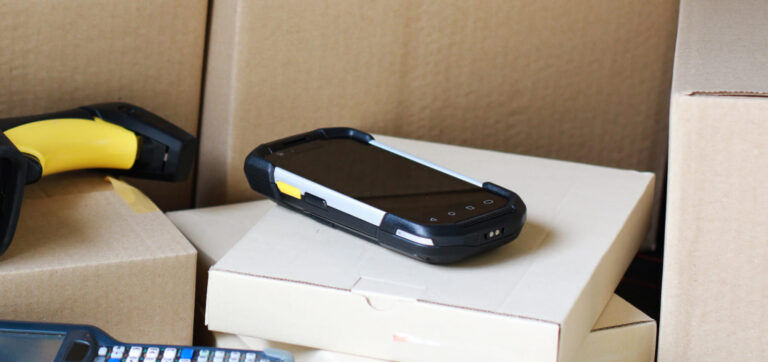Barcodes are everywhere. Nowadays, we can just scan them with our phones, but before high-resolution cameras became common in smartphones, dedicated handheld scanners were the norm. First wired, then increasingly wireless.
And while these dedicated scanning devices are still widely used in some industries, like retail, many enterprises have switched to smartphone-based scanners running Android. Unlike consumer models, these devices often feature extras like rugged cases protecting them from fall damage, dust, and water, or dedicated scan buttons.
Let’s take a closer look at the benefits of using Android-based handheld barcode scanners – as well as their downsides.
Advantages of Android-based handheld barcode scanners
Smartphone-based barcode scanners improve on traditional dedicated scanning devices in many ways. They not only combine hardware- and software-based scanning, but are also more flexible and easier to upgrade.
Combining hardware- and software-based scanning
1D barcodes (e.g., UPC, EAN, or Interleaved 2 of 5) were made with laser scanning technology in mind. This means that hardware-based laser scanners can often scan them faster than devices using a camera.
On the other hand, 2D barcodes (e.g., QR, Data Matrix, or Aztec) are best read using a camera-based scanner. In fact, many laser scanners are incapable of reading them. Since they can encode more complex information (e.g., bank transfer details or medication plans), having a screen for outputting the information to the user is more or less a necessity.
Android-based scanning devices use barcode scanning software and the built-in device camera to read both 1D and 2D barcodes. Some models additionally include a laser scanner for 1D barcode use cases. This makes them a versatile tool for any industry.
Flexibility
Classic hardware-based barcode scanners do one thing only: scan barcodes. For Android-based barcode scanners, reading barcodes is just one among many features.
Since these scanners are also fully-fledged smartphones, they can be used to make calls, take pictures, scan documents, or send text messages. They’re also connected to the internet and can access company servers via WiFi.
This flexibility makes Android-based barcode scanners highly useful multi-purpose tools.
Upgradability
Software is far more malleable than hardware. This means that the feature set of any digital device can – in theory – be expanded post-purchase.
Therefore, choosing the right vendor is critical. Barcode scanning software should receive regular updates that add support for additional barcode types while refining the scanning capabilities for existing ones. Ideally, this should come at no extra cost.
If these conditions are met, opting for software-based barcode scanning can be an excellent investment.
Disadvantages of Android-based handheld barcode scanners
Despite their versatility, smartphones designed explicitly for scanning barcodes also have drawbacks you should consider before making a buying decision.
Outdated Android versions
Android-based handheld barcode scanners often run operating systems that are already several years old at the time of purchase.
A major reason for this is that upgrading Android on an enterprise device is laborious and costly – it requires extensive regression testing and recertification to comply with industry regulations. Consequently, handheld scanner manufacturers mostly remain on a specific Android version for as long as possible.
This means that while the manufacturer-installed software (including the barcode scanner) will run without issues, the same cannot be guaranteed for any apps you might want to install in addition to that. In the worst case, they won’t run at all.
At the time of writing, many Android-based handheld scanners still use Android 7 (codename “Nougat”, specifically API level 24), which came out in 2016.
Lack of customization options
There is a limit to the customizability of hardware scanners, since adapting their functionalities to each customer’s needs is unfeasible.
This is not the case for barcode scanning software. It costs very little to copy and adapt programming code, which allows for deep customization. In theory, any company with the technical expertise and access to the scanning software’s code could adapt it to their specific needs.
However, most Android-based handheld scanners ship with an off-the-shelf barcode scanning solution that offers few customization options. This makes the software-based approach much less powerful than it could be.
Low-spec hardware
Barcode scanners built on top of Android phones are made for a specific purpose, one that doesn’t require high-end hardware. Unfortunately, this often shows in these devices’ specifications.
This can lead to frustrations when using any app not pre-installed on the device: Apps designed for more powerful devices may struggle to run smoothly on underpowered hardware, resulting in many hiccups and crashes.
Considering the typical price point of Android-based handheld barcode scanners, it’s unfortunate that their technical specifications are not on par with those of consumer smartphones. This means you mainly pay for the extra accessories – and the manufacturer’s barcode scanning software.
Skip the expensive hardware – buy the barcode scanning software directly!
We at Scanbot SDK believe in software-based solutions not bound to specific hardware. That’s why we developed a device-agnostic Barcode Scanner SDK that you can integrate into any mobile or web app.
Whether you’re running Android, iOS, Windows, Linux, or a web server – we offer a version of our barcode scanning solution that perfectly fits your tech stack.
Leveraging the power of on-device computer vision and machine learning, our SDK makes the most of your smartphone’s, tablet’s, or even drone’s hardware to read both 1D and 2D barcodes fast and reliably. No data ever leaves the device.
It also offers special scanning modes for reading many barcodes in quick succession or all at once – with a special AR overlay to help you achieve flawless results.We offer the Scanbot Barcode Scanner SDK at a fixed yearly fee, regardless of the number of scans or devices. This fee includes developer support and regular updates.







